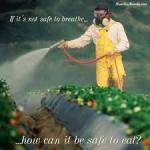What is sustainable food? Why is this term thrown about so much lately? Chefs, food bloggers, and TV hosts are speaking of sustainability on a regular basis. But, what does this mean and do they fully understand the concept, or is it just the latest foodie catch-phrase?

If you’d like to find the freshest food, store it correctly and know HOW to cook it right, you’ll love my FREE webinar, How To Cook Fresh in 5 Simple Steps.
The dictionary says “sustain” is to “maintain”, “support”, or “endure”. When applied to a food system, sustainability means that the items grown will maintain or support the ability of future growth to endure. More simply, one crop won’t mess up the chances for a second crop to grow.
In 1987, the United Nations defined it as: “sustainable development is development that meets the needs of the present without compromising the ability of future generations to meet their own needs.”
This 2 minute animation explains sustainability:
Sustainability means the farmer returns to the land no less than he’s taken out. It also means he doesn’t leave behind waste, pesticides, or take nutrients from the soil that can’t be returned naturally.
This has been the way to farm since the dawn of agriculture. The earliest farmers knew that crop rotation was important. Some fruits and vegetables deplete the soil of specific nutrients; others return the needed elements for the next generation. It was done naturally by growing a variety of plants in the same soil in succession.
Rob Endelman explains in this 1 minute video:
Similarly, as long as there has been a grazing animal on this earth, nature has taken care of the balance between use and reuse. The natural cycle meant that cows eat grass and defecate. The cow patties attract flies and bugs that leave their larva behind. Birds and chickens eat the larva and further fertilize the land. This grows more grass for the grazing animals to eat. It’s endlessly sustainable.
Today’s modern feed-lot packs thousands of animals into a crowded contained area. There’s no grass, just engineered corn feed. The defecation is pumped into large sewage pools and held there. The feed-lot grows cows for beef and nothing else. It’s a dead end that takes more from the land than it gives. It’s unsustainable.
 Produce farmers that deplete the soil and return nutrients through chemicals rather than crop rotation are taking more than they give. Farmers who use powerful pesticides or grow seeds that have been genetically modified are taking more than they give. It’s unsustainable and impugns the ability of future generations to grow wholesome ingredients there.
Produce farmers that deplete the soil and return nutrients through chemicals rather than crop rotation are taking more than they give. Farmers who use powerful pesticides or grow seeds that have been genetically modified are taking more than they give. It’s unsustainable and impugns the ability of future generations to grow wholesome ingredients there.
If you’re a locavore then you are purchasing your food from someone who most likely LIVES on the farm they tend. I’d imagine they’re family farmers who want to PROTECT their land for their children and grandchildren. They want their family to be sustainable just like their food and farm.
When you go to the farmers market this weekend, ask your favorite farmer how many generations have been working his land. Ask him if he’d ever till his soil with chemicals that would make it difficult to grow food for future generations. Gauge his reaction as you suggest that he use his land as if it’s disposable rather than sustainable. Then run, he’ll be mad.


Great article…wonderful resource! Thanks for writing about such an important concept…
Thank you, Lauryn for your comment.